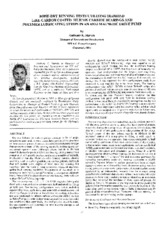| dc.description.abstract | Dry run failures in sealless pumps continue to be of major concern to users and, in some cases, have precluded the purchase of these types of pumps. Users are demanding robust pump designs that are more tolerant of dry running caused by system upsets and occasional operator error. Although silicon carbide is the best material choice for product lubricated bearings during normal wet operation, it will quickly overheat and seize in a matter of seconds, if allowed to run dry. There are other bearing material choices available, such as carbon-graphite and various polymer materials that will permit some degree of short term dry running, but sacrifices must be made in wear resistance, chemical inertness, and/or load carrying capability. The purpose of this study is to investigate the bone-dry run performance of amorphous diamond-like carbon (ADLC) coated silicon carbide bearings both with and without Teflon lubricating strips. The test pump was a 1.5X1X6 ANSI magnetic drive pump fitted with a nonconductive containment shell and rated for 7.5 hp at 3600 rpm. Ten bearing configurations were tested, including repeatability tests, cycle tests, and tests with covered suction and discharge flanges to eliminate the effect of air cooling. A baseline test was conducted for silicon carbide without the ADLC coating or Teflon strips in order to determine survivability under bone-dry run conditions. Not surprisingly, this configuration seized in under five sec operation and sustained the most massive damage of all configurations tested. Results showed that the configuration with ADLC SiC(P) bearings and Teflon lubricating strips was superior to all configurations tested. During this test, the maximum bearing temperature leveled off at 139 degrees F after five hours of bone-dry run operation. This configuration had the longest operating time, lowest temperature rise, and least wear of all configurations tested. An examination showed that the SiC bearings had virtually no damage and it was expected that this configuration could have continued to run bone-dry for many more hours. The bearing configuration with ADLC SiC(P) without Teflon strips also performed well and had an average bone-dry run time of 142 min prior to reaching the 300 degree F bearing temperature limit previously set for terminating the test. Post-test bearing condition for this configuration was good with only light to moderate scoring evident. It was found through repeatability testing that the dry run performance of the ADLC coating SiC(P) bearings was reasonably consistent. Prior experience with this coating indicated that it had significantly contributed to a 62 percent reduction in failure rate, during a frequency of repair audit at a large German chemical plant. | en |


